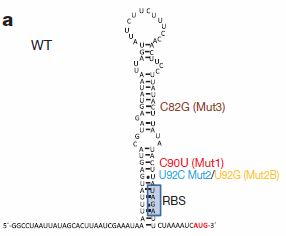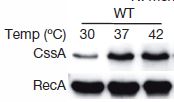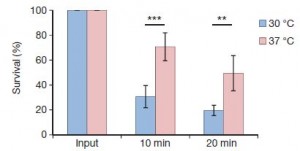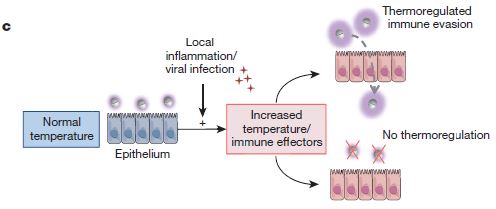Bacteria responding positively to fever?
The article: Loh, E. et al. (2013) “Temperature triggers immune evasion by Neisseria meningitidis.” Nature online publication doi:10.1038/nature12616
Subject areas: Microbiology, Molecular Biology
Vocabulary:
meninges – three thin membranes that cover the brain and spinal cord. The outermost and relatively strong layer is the dura mater, the middle layer is the arachnoid, and the layer closest to the brain is the pia mater. The dura and the arachnoid also contain and support blood vessels.
commensal – in ecological systems, commensal organisms obtain food or other benefits from a host organism, but neither hurt nor help the host.
—–
Meningitis refers to inflammation of the meninges, which are a set of protective membranes that ensheath the brain and spinal cord. The cause of the inflammation can vary, but is usually either bacterial or viral, although it can also be caused by parasites, fungi, physical injury, and some drugs and other diseases. Bacterial meningitis is usually a serious medical problem in the United States, causing about 500 deaths in 4100 cases every year (numbers from Thigpen et al, 2011, N. Engl. J. Med. 364:2016-25). The symptoms themselves can be severe and could cause brain damage, and it is also a transmissible disease through close respiratory contact like kissing, or being directly coughed on. The bacteria that cause this are hardy, and manage to escape initial immune system attempts at eradication.
What they knew.
Neisseria meningitidis is a common cause of bacterial meningitis in all age groups except newborns. However, because it is an obligate commensal of humans, and particularly of the nasopharyngeal membranes, it does not normally “want” to invade the patient to the point of great sickness or potential death, because that would be an evolutionary dead end: dead human host = dead N. meningitidis. Meningitis caused by Neisseria usually starts with co-infection by some other bacteria, with the N. meningitidis making some changes to protect itself from the activated immune system and spread from its usual nasopharyngeal location into the meninges.
The really neat trick is that the changes the Neisseria make do not occur until necessary, i.e. until the immune system is activated. The major change is to create a polysaccharide capsule, or protective shell, around the bacterium, but the bacteria also begin to secrete a protein that can modulate the host immune system, and an enzyme that modifies some of the molecules on the surface of the bacteria so that they are less easily recognizable by the immune system.
Looking at the genes responsible for these three changes in the bacteria, the authors noticed something interesting. The region just before (upstream of) the start of the coding region looked like it would form a stem-loop structure. What’s a stem-loop?
 Remember that nucleic acids are made of nucleotides: adenine (A), guanine (G), cytosine (C), and thymine (T) in DNA, and similarly except uracil (U) instead of thymine in RNA molecules. Remember that in the double-stranded DNA molecule, A pairs with T, and G pairs with C. So sometimes in RNA, which is usually single-stranded, if the right sequences happen to fold up next to one another, the A’s pair with U’s and the G’s pair with C’s, forming a small double-stranded region. That is the “stem”. If there are a few nucleotides that do not pair up in the middle of the sequence, they form a “loop”.
Remember that nucleic acids are made of nucleotides: adenine (A), guanine (G), cytosine (C), and thymine (T) in DNA, and similarly except uracil (U) instead of thymine in RNA molecules. Remember that in the double-stranded DNA molecule, A pairs with T, and G pairs with C. So sometimes in RNA, which is usually single-stranded, if the right sequences happen to fold up next to one another, the A’s pair with U’s and the G’s pair with C’s, forming a small double-stranded region. That is the “stem”. If there are a few nucleotides that do not pair up in the middle of the sequence, they form a “loop”.
Now recall how a protein gets made from a gene. The DNA sequence is transcribed into an RNA molecule. Then a piece of cellular machinery called the ribosome finds a specific sequence upstream of the coding region to bind onto and assemble. Finally, it moves along the RNA to read the sequence and attach amino acids together in the right sequence to make a protein.
The idea here is that the stem-loop structure in these Neisseria genes were in that region where the ribosome needs to bind onto to make these proteins.
What they did.
So under normal conditions, the stem-loops structure forms up as expected, and that prevents the ribosome from binding on the RNA and making the proteins. However, because the bonds holding the stem together are only weak hydrogen bonds, they can be broken simply by increasing the temperature. This leads to a possible mechanism for coordinating the expression of these protective genes with an imminent threat from the immune system.
When the immune system is activated, the inflammation response elevates the temperature. The investigators had to determine if the difference in temperature was enough to break the stem-loops preventing the genes from being translated into proteins.
 They started with the CssA gene, which encodes an important enzyme for making the protective capsule. As the figure clearly shows, there is an increase in CssA protein at 37 degrees compared to 30 degrees. As a control, the non-heat-sensitive RecA gene product was also checked, and there is no change in expression. In subsequent experiments, they also show that they can move this out of N. meningitidis and do the same experiment in a different bacteria, and even in vitro, all with similar results. They also found a similar temperature sensitivity in the expression of fHbp (the gene for factor H binding protein, which modulates the immune response) and Lst (the gene for lipopolysaccharide sialyltransferase, which modifies the bacterial cell surface).
They started with the CssA gene, which encodes an important enzyme for making the protective capsule. As the figure clearly shows, there is an increase in CssA protein at 37 degrees compared to 30 degrees. As a control, the non-heat-sensitive RecA gene product was also checked, and there is no change in expression. In subsequent experiments, they also show that they can move this out of N. meningitidis and do the same experiment in a different bacteria, and even in vitro, all with similar results. They also found a similar temperature sensitivity in the expression of fHbp (the gene for factor H binding protein, which modulates the immune response) and Lst (the gene for lipopolysaccharide sialyltransferase, which modifies the bacterial cell surface).
 Now that they know these potentially protective genes are temperature-sensitive, can they show that activation of these genes actually improves survival? The experiment was to take a culture of N. meningitidis that was incubated at 30 C for an hour and compare them to a culture that had been incubated at 37 C. Both were exposed to human immune serum to determine survival. The graph at right shows that there is significantly improved survival from the bacteria exposed to the higher temperature.
Now that they know these potentially protective genes are temperature-sensitive, can they show that activation of these genes actually improves survival? The experiment was to take a culture of N. meningitidis that was incubated at 30 C for an hour and compare them to a culture that had been incubated at 37 C. Both were exposed to human immune serum to determine survival. The graph at right shows that there is significantly improved survival from the bacteria exposed to the higher temperature.
What they concluded.
Inflammation due to infection by another bacteria or virus (for example, the flu virus) will increase temperature. The activated immune system also secretes factors and enzymes that can attack the Neisseria meningitidis even if it wasn’t the pathogen that activated the system in the first place. That is because the immediate immune response is relatively non-specific. N. meningitidis that have the heat-sensitive genes will have advance warning of the coming threat, allowing it to activate its own protection and also cause it to migrate from the surface of the nasal passages into the bloodstream. The bloodstream is considerable warmer than the nasopharyngeal surface, so the protective genes are kept on, to allow the Neisseria to survive until the immune system has returned to an inactive state.


No comments
Be the first one to leave a comment.